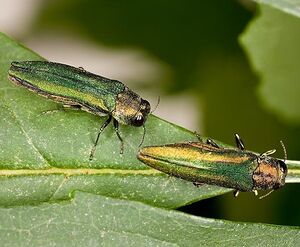Jewel Beetle: Difference between revisions
No edit summary |
No edit summary |
||
| Line 13: | Line 13: | ||
==Diet & Food Behavior== | ==Diet & Food Behavior== | ||
Jewel Beetles are active during the day and spend the night hiding under leaves and other plant material they can find along the ground. Their diet consists of leaves, nectar, stems, roots, and soft/dead trees and grasses. Some beetles tend to target crops on | Jewel Beetles are active during the day and spend the night hiding under leaves and other plant material they can find along the ground. Their diet consists of leaves, nectar, stems, roots, and soft/dead trees and grasses. Some beetles tend to target crops on farm fields and can cause large amounts of economic damage [5]. | ||
==Habitat and Distribution== | |||
Jewel beetles live in forests and woodlands. Many species are found in Australia and can be seen feeding on and flying around flowers in these forests [1]. Some species like the above [[Emerald Ash Borer]] are extremely invasive and take over large areas. Jewel Beetles can be found all over the world, but are tended to cluster in Australia and warmer climates. Places that have a large hand made jewelry businesses also can see a spike in these beetles [1]. Hence the name Jewel Beetle. | |||
Revision as of 23:25, 10 May 2022
The Jewel Beetles is a group also known as the Buprestidae. In this family of beetles, there are over 15,500 different species and are ranged all over the world. Another common name for this group is the metallic wood-boring beetle. This is due to their shiny iridescent like body [1]. This group is the most common collected beetle type for insect collectors, strictly due to the bright and showy colors. One of the most famous examples of a beetle from this family is the emerald ash borer, an invasive beetle that is terrorizing all of the ash trees in North America [2].
Taxonomy
Kingdom: Animalia
Phylum: Arthopoda
Subphylum: Uniramia
Class: Insecta
Order: Coleoptera
Sub Order: Polyphaga
Family: Buprestidae

Description
Jewel Beetles are easily identified due to their elongated and oval bodies tapering to a point near the end. Their lengths can measure anywhere from 3mm to 80mm, however, many species are below the 20mm mark [2]. They are hard bodied insects, rather than flat. Their colors range from many different shades. Some examples being dull browns and blacks all the way to neon and chrome greens and purples [2]. Their color is created in a different way than many others. They have a textured cuticle which reflects the light differently, causing the bright patterns and different hues of colors [4]. The larvae tunnel their way inside the interior of the host's tree trunk and emerge from the bark when they are ready and matured [3]. Usually focusing on dead on decaying branches on healthy trees, this is where the first part of the life cycle beings for the Jewel Beetle family [4]. There are four stages of life within these beetles. The egg, larva, pupa, and adult. Once adults, they die in a relatively short time frame. Most species only live between a few days and 3 weeks [5].
Diet & Food Behavior
Jewel Beetles are active during the day and spend the night hiding under leaves and other plant material they can find along the ground. Their diet consists of leaves, nectar, stems, roots, and soft/dead trees and grasses. Some beetles tend to target crops on farm fields and can cause large amounts of economic damage [5].
Habitat and Distribution
Jewel beetles live in forests and woodlands. Many species are found in Australia and can be seen feeding on and flying around flowers in these forests [1]. Some species like the above Emerald Ash Borer are extremely invasive and take over large areas. Jewel Beetles can be found all over the world, but are tended to cluster in Australia and warmer climates. Places that have a large hand made jewelry businesses also can see a spike in these beetles [1]. Hence the name Jewel Beetle.